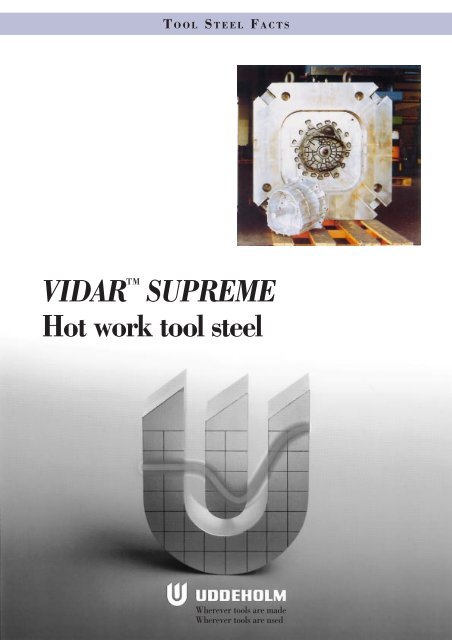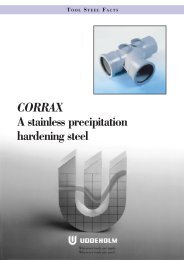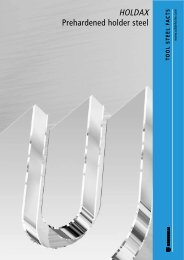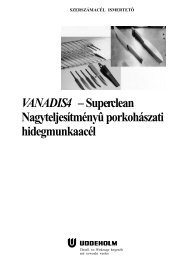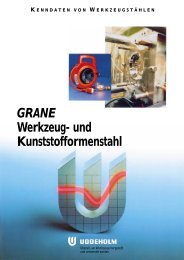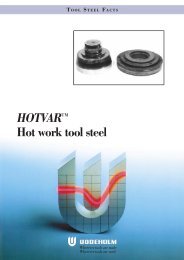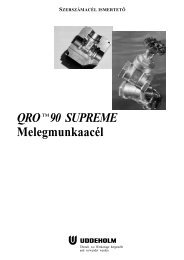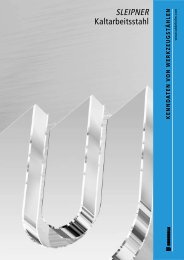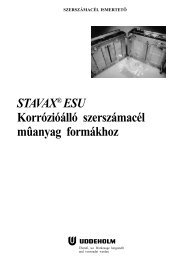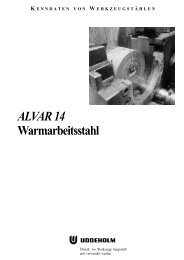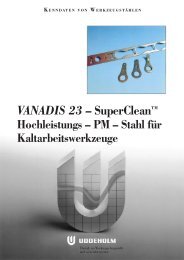VIDAR™ SUPREME Hot work tool steel - Uddeholm
VIDAR™ SUPREME Hot work tool steel - Uddeholm
VIDAR™ SUPREME Hot work tool steel - Uddeholm
Create successful ePaper yourself
Turn your PDF publications into a flip-book with our unique Google optimized e-Paper software.
T OOL STEEL FACTS<br />
VIDAR <strong>SUPREME</strong><br />
<strong>Hot</strong> <strong>work</strong> <strong>tool</strong> <strong>steel</strong><br />
Wherever <strong>tool</strong>s are made<br />
Wherever <strong>tool</strong>s are used
2<br />
VIDAR<br />
<strong>SUPREME</strong><br />
This information is based on our present state of knowledge and is<br />
intended to provide general notes on our products and their uses.<br />
It should not therefore be construed as a warranty of specific<br />
properties of the products described or a warranty for fitness for a<br />
particular purpose.
General<br />
VIDAR <strong>SUPREME</strong> is a chromium-molybdenumvanadium<br />
alloyed hot <strong>work</strong> <strong>tool</strong> <strong>steel</strong> which is<br />
characterized by:<br />
• High level of resistance to thermal shock and<br />
thermal fatigue<br />
• Good high-temperature strength<br />
• Excellent toughness and ductility in all<br />
directions<br />
• Uniform and high level of machinability<br />
• Excellent through-hardening properties<br />
• Good dimensional stability during hardening.<br />
Typical C Si Mn Cr Mo V<br />
analysis % 0,38 1,0 0,4 5,0 1,3 0,4<br />
Standard AISI H11, B H11, W.-Nr. 1.2343,<br />
specification<br />
Delivery<br />
AFNOR Z38 CDV 5,<br />
UNI X37 CrMoV 51 KU,<br />
UNE X37 CrMoV 5<br />
condition Soft annealed to approx.180 HB<br />
Colour code Orange/red<br />
IMPROVED TOOLING PERFORMANCE<br />
The name “<strong>SUPREME</strong>” implies that by special<br />
processing techniques and close process control,<br />
the <strong>steel</strong> attains high purity and a very fine structure.<br />
Further, VIDAR <strong>SUPREME</strong> shows significant<br />
improvements in isotropic properties compared to<br />
conventionally produced material of the X38 CrMo<br />
V 51 (W.-Nr. 1.2343) type.<br />
These improved isotropic properties are particularly<br />
valuable for <strong>tool</strong>ing subjected to high mechanical<br />
and thermal stresses, e.g. die casting dies and<br />
forging <strong>tool</strong>s. In practical terms, <strong>tool</strong>s may be used<br />
at somewhat higher <strong>work</strong>ing hardnesses (2 HRC)<br />
without loss of toughness. Since increased service<br />
hardness limits the formation of heat checking<br />
cracks, improved <strong>tool</strong> performance can be expected.<br />
Applications<br />
TOOLS FOR DIE CASTING<br />
Tin, lead,<br />
Aluminium-,<br />
Magnesium<br />
zinc alloys alloys<br />
Part HRC HRC<br />
Dies 46–50 42–48<br />
Fixed inserts, cores 48–52 46–50<br />
Sprue parts (ORVAR) (ORVAR)<br />
Nozzles (ORVAR) (ORVAR)<br />
Ejector pins (nitrided)<br />
Plunger, shot-sleeve<br />
(ORVAR) (ORVAR)<br />
(normally nitrided) (ORVAR) (ORVAR)<br />
Austenitizing 990°C 1000°C<br />
temperature (1814°F) (1832°F)<br />
TOOLS FOR HOT PRESSING<br />
VIDAR<br />
<strong>SUPREME</strong><br />
Material<br />
Aluminium,<br />
Austenitizing<br />
temperature (approx.) HRC<br />
magnesium 1000°C (1832°F) 44–52<br />
Copper alloys 1000°C (1832°F) 44–52<br />
Steel 1000°C (1832°F) 40–50<br />
OTHER APPLICATIONS<br />
Application<br />
Austenitizing<br />
temperature (approx.) HRC<br />
Severe cold 1000°C (1832°F)<br />
punching, Tempering: 52–54<br />
scarp shears 250°C (482°F)<br />
Shrink rings 1000°C (1832°F)<br />
(e.g. for cemented Tempering:<br />
carbide dies) 575–600°C<br />
(1067–1112°F)<br />
45–50<br />
Wear-resisting 1000°C (1832°F) Core<br />
parts Tempering: 50–52<br />
575°C (1067°F) Surface<br />
+ Nitriding ~1000 HV0,2<br />
3
4<br />
VIDAR<br />
<strong>SUPREME</strong><br />
Properties<br />
PHYSICAL DATA<br />
All specimens are taken from the centre of a 500 x<br />
110 mm (19,7" x 4,3") bar. Unless otherwise is indicated<br />
all specimens were hardened from 1000°C<br />
(1832°F), quenched in air and tempered 2 + 2h at<br />
610°C (1130°F). The hardness were 45 ±1 HRC.<br />
Temperature 20°C 400°C 600°C<br />
Density,<br />
(68°F) (750°F) (1010°F)<br />
kg/m3 7 800 7 700 7 600<br />
lbs/in3 Modulus of elasticity<br />
0,281 0,277 0,274<br />
MPa 210 000 180 000 140 000<br />
psi 30,5 x 106 26,1 x 106 20,3 x 106 Coefficient of<br />
thermal expansion<br />
per °C from 20°C – 12,6 x 10 –6 13,2 x 10 –6<br />
per °F from 68°F – 7,0 x 10 –6 7,3 x 10 –6<br />
Thermal<br />
conductivity<br />
W/m °C 25 29 30<br />
Btu in/(ft 2 h°F) 176 204 211<br />
MECHANICAL PROPERTIES<br />
Approximate tensile strength at room temperature.<br />
Hardness 44 HRC<br />
Tensile strength, Rm 1410 MPa 144 kp/mm2 Yield strength, Rp0,2 1170 MPa 119 kp/mm 2<br />
Elongation, A5 12%<br />
Reduction in area, Z 50%<br />
Approximate strength at elevated temperatures<br />
Longitudinal direction.<br />
psi Rm, Rp0.2<br />
1000x MPa<br />
290 2000<br />
261 1800<br />
232 1600<br />
203 1400<br />
174 1200<br />
145 1000<br />
116 800<br />
87 600<br />
58 400<br />
29 200<br />
0<br />
Rp0,2<br />
A5<br />
Rm<br />
A5,<br />
Z %<br />
100<br />
90<br />
80<br />
70<br />
60<br />
50<br />
40<br />
30<br />
20<br />
10<br />
100 200 300 400 500 600 700 °C<br />
210 390 570 750 930 1110 1290 °F<br />
Testing temperature<br />
Z<br />
Effect of time at high temperatures on hardness<br />
Hardness, HRC<br />
50<br />
45<br />
40<br />
35<br />
30<br />
25<br />
20<br />
1 10 100 1000<br />
Time, h<br />
Effect of testing temperatures on impact energy<br />
Charpy V specimens, short transverse direction.<br />
ft. lbs Impact energy, J<br />
74<br />
59<br />
44<br />
30<br />
15<br />
100<br />
80<br />
60<br />
40<br />
20<br />
0<br />
650°C (1202°F)<br />
500°C<br />
(932°F)<br />
550°C (1022°F)<br />
600°C<br />
(1112°F)<br />
45 HRC<br />
100 200 300 400 500 °C<br />
210 390 570 750 930 °F<br />
Testing temperature °C
Heat treatment<br />
SOFT ANNEALING<br />
Protect the <strong>steel</strong> and heat through to 850°C<br />
(1562°F). Then cool in furnace at 10°C (20°F) per<br />
hour to 650°C (1202°F), then freely in air.<br />
STRESS RELIEVING<br />
After rough machining the <strong>tool</strong> should be heated<br />
through to 650°C (1202°F), holding time 2 hours.<br />
Cool slowly to 500°C (932°F), then freely in air.<br />
HARDENING<br />
Preheating temperature: 600–850°C (1112–1562°F)<br />
(normally two preheating steps).<br />
Austenitizing temperature: 990–1010°C (1814–<br />
1850°F), normally 990–1000°C (1814–1832°F).<br />
Soaking time: 30–45 minutes. Soaking time = time<br />
at austenitizing temperature after the <strong>tool</strong> is fully<br />
heated through.<br />
Protect the <strong>tool</strong> against decarburization and oxidation<br />
during austenitizing.<br />
CCT graph<br />
Austenitizing temperature1000°C (1832°F). Holding time 30 minutes.<br />
°F °C<br />
2000 1100<br />
1800 1000<br />
900<br />
1600<br />
800<br />
1400<br />
700<br />
1200<br />
600<br />
1000<br />
500<br />
800<br />
400<br />
600 300<br />
M<br />
s<br />
400<br />
200<br />
200<br />
100<br />
M<br />
f<br />
Carbides<br />
Martensite<br />
Pearlite<br />
Bainite<br />
1 2 3 4 5 6 7 8<br />
Austenitizing temperature 1000°C (1832°F)<br />
Holding time 30 min.<br />
1 10 100 1000 1 000 10 10 000 100 100 000 Seconds<br />
1 10 100 1000 1 000 Minutes<br />
1 10 100 Hours<br />
Air cooling<br />
Air cooling of<br />
0,2 1,5 10 90 600 bars, of bars,Ø Ø mm mm<br />
0,0079 0,059 0,394 3,54 23,6 inchØ<br />
inch<br />
=<br />
VIDAR<br />
<strong>SUPREME</strong><br />
QUENCHING MEDIA<br />
• High speed gas/circulating atmosphere.<br />
• Vacuum (high speed gas with sufficient positive<br />
pressure).<br />
• Martempering bath (salt or fluidized bed) at<br />
500–550°C (932–1022°F).<br />
• Martempering bath (salt or fluidized bed) at<br />
180–220°C (356–428°F).<br />
• Warm oil.<br />
Note 1: Temper the <strong>tool</strong> as soon as its temperature<br />
reaches 50–70°C (122–158°F).<br />
Note 2: In order to obtain the optimum properties<br />
for the <strong>tool</strong>, the cooling rate should be fast, but not<br />
at a level that gives excessive distortion or cracks.<br />
A 915°C (1680°F)<br />
C3<br />
A 850°C (1562°F)<br />
C1<br />
Cooling Hardcurve<br />
ness T 800–500<br />
No. HV 10 (sec)<br />
1 715 2<br />
2 715 13<br />
3 695 125<br />
4 654 374<br />
5 642 623<br />
6 642 1248<br />
7 559 5200<br />
8 459 10400<br />
5
6<br />
VIDAR<br />
<strong>SUPREME</strong><br />
Hardness, grain size and retained austenite as a<br />
function of austenitizing temperature<br />
Grain size<br />
ASTM Hardness, HRC<br />
Retained austenite %<br />
10 60<br />
58<br />
Hardness<br />
8 56<br />
6<br />
54<br />
52<br />
50<br />
Grain size<br />
4<br />
48<br />
8<br />
2<br />
46<br />
44<br />
Retained austenite<br />
6<br />
4<br />
42<br />
2<br />
Tempering graph<br />
Air cooling of specimen 15 x 15 x 40 mm (0,6" x<br />
0,6" x 1,6")<br />
Hardness, HRC Retained austenite %<br />
58<br />
56<br />
54<br />
52<br />
50<br />
48<br />
46<br />
44<br />
42<br />
40<br />
38<br />
36<br />
34<br />
32<br />
30<br />
28<br />
26<br />
980 990 1000 1010 1020 °C<br />
1796 1814 1832 1850 1868 °F<br />
Austenitizing temperature<br />
TEMPERING<br />
Choose the tempering temperature according to<br />
the hardness required by reference to the tempering<br />
graph below. Temper twice with intermediate<br />
cooling to room temperature. Lowest tempering<br />
temperature 180°C (356°F). Holding time at temperature<br />
minimum 2 hours. To avoid brittleness do<br />
not temper in the range 425–550°C (797–1022°F).<br />
Austenitizing temperature<br />
1000°C (1832°F)<br />
Retained austenite<br />
100 200 300 400 500 600 700 800 °C<br />
212 392 572 752 932 1112 1292 1472 °F<br />
Tempering temperature (2 + 2h)<br />
8<br />
6<br />
4<br />
2<br />
0<br />
Approximate impact strength at different tempering<br />
temperatures.<br />
Charpy V specimens, short transverse direction.<br />
ft.lb.<br />
74<br />
59<br />
44<br />
30<br />
15<br />
Impact strength<br />
- KV Joule<br />
100<br />
80<br />
60<br />
40<br />
20<br />
0<br />
100 200 300 400 500 600 °C<br />
200 400 600 800 1000 1200 °F<br />
Tempering temperature (2h + 2h)<br />
Tempering within the range 425–550°C (797–<br />
1022°F) is normally not recommended due to<br />
impaired toughness.<br />
DIMENSIONAL CHANGES DURING<br />
HARDENING AND TEMPERING<br />
During hardening and tempering the die is exposed<br />
to thermal as well as transformation<br />
stresses. This will inevitably result in dimensional<br />
changes and in the <strong>work</strong> case distortion. It is therefore<br />
recommended to always leave a machining<br />
allowance after machining before the die is hardened<br />
and tempered. Normally the size in the largest<br />
direction will shrink and the size in the smallest<br />
direction might increase but this is also a matter of<br />
the die size, the die design as well as the cooling<br />
rate after hardening.<br />
For VIDAR <strong>SUPREME</strong> it is recommended to leave<br />
a machining allowance of 0,2 per cent of the dimension<br />
in length, width and thickness.<br />
NITRIDING AND NITROCARBURIZING<br />
Nitriding and nitrocarburizing result in a hard surface<br />
layer which is very resistant to wear and erosion.<br />
The nitrided layer is, however, brittle and my<br />
crack or spall when exposed to mechanical or thermal<br />
shock, the risk increasing with layer thickness.<br />
Before nitriding, the <strong>tool</strong> should be hardened<br />
and tempered at a temperature at least 50°C<br />
(120°F) above the nitriding temperature.<br />
Nitriding in ammonia gas at 510°C (950°F) or<br />
plasma nitriding in a 75% hydrogen/25% nitrogen<br />
at 480°C (896°F) both result in a surface hardness<br />
of 1100 HV0,2. In general, plasma nitriding is the<br />
preferred method because of better control over<br />
nitrogen potential; in particular, formation of the<br />
so-called “white layer”, which is not recommended<br />
of hot-<strong>work</strong> service, can readily be avoided. However,<br />
careful gas nitriding can give perfectly acceptable<br />
results.
VIDAR <strong>SUPREME</strong> can also be nitrocarburized in<br />
either gas or salt bath. The surface hardness after<br />
nitrocarburizing is 900–1000 HV0,2.<br />
DEPTH OF NITRIDING<br />
Depth<br />
Process Time mm inch<br />
Gas nitriding 10 h 0,12 0,0047<br />
at 510°C (950°F) 30 h 0,20 0,0079<br />
Plasma nitriding 10 h 0,14 0,0055<br />
at 480°C (895°F)<br />
Nitrocarburizing<br />
– in gas at<br />
30 h 0,19 0,0075<br />
580°C (1075°F)<br />
– in salt bath at<br />
2,5 h 0,12 0,0047<br />
580°C (1075°F) 1 h 0,07 0,0028<br />
* Depth of case = distance from surface where hardness<br />
is 50 HV 0,2 over base hardness.<br />
Nitriding to case depths >0,3 mm (0,012") is not<br />
recommended for hot-<strong>work</strong> applications. VIDAR<br />
<strong>SUPREME</strong> can also be nitrided in the soft annealed<br />
condition. The hardness and depth of case<br />
will, however, be reduced somewhat in this case.<br />
Cutting data<br />
recommendations<br />
The cutting data below are to be considered as<br />
guiding values which must be adapted to existing<br />
local condition.<br />
DRILLING<br />
High speed <strong>steel</strong> twist drill<br />
Drill diameter Cutting Feed (f)<br />
speed (vc)<br />
mm inch m/min f.p.m. mm/r i.p.r.<br />
– 5 –3/16 17* 56* 0,08–0,20 0,003–0,008<br />
5–10 3/16–3/8 17* 56* 0,20–0,30 0,008–0,012<br />
10–15 3/8–5/8 17* 56* 0,30–0,35 0,012–0,014<br />
15–20 5/8–3/4 17* 56* 0,35–0,40 0,014–0,016<br />
1) For coated HSS drill vc ~24 m/min. (80 f.p.m.).<br />
Carbide drill<br />
Cutting data Indexable<br />
Type of drill<br />
Solid Brazed<br />
parameters insert carbide carbide1) Cutting<br />
speed (vc)<br />
m/min 180–220 80 60<br />
f.p.m.<br />
Feed (f)<br />
600–735 265 200<br />
mm/r 0,03–0,102) 0,10–0,252) 0,15–0,252) i.p.r. 0,001–0,0042) 0,004–0,012) 0,006–0,012) 1) Drill with internal cooling channels and brazed carbide<br />
tip.<br />
2) Depending on drill diameter.<br />
TURNING<br />
VIDAR<br />
<strong>SUPREME</strong><br />
Turning with Turning<br />
carbide with high<br />
Cutting data speed <strong>steel</strong><br />
parameters Rough turning Fine turning Fine turning<br />
Cutting<br />
speed (vc)<br />
m/min 150–200 200–250 30<br />
f.p.m.<br />
Feed (f)<br />
500–665 665–835 100<br />
mm/r 0,3–0,6 –0,3 –0,3<br />
i.p.r.<br />
Depth<br />
0,01–0,024 –0,01 –0,01<br />
of cut (ap)<br />
mm 2–6 –2 –2<br />
inch<br />
Carbide<br />
designation<br />
0,08–0,24 –0,08 –0,08<br />
ISO P20–P30 P10 –<br />
Coated carbide Coated carbide<br />
or cermet<br />
MILLING<br />
Face- and square shoulder milling<br />
Milling with Milling<br />
carbide with high<br />
Cutting data speed <strong>steel</strong><br />
parameters<br />
Cutting<br />
Rough milling Fine milling Fine milling<br />
speed (vc)<br />
m/min 160–210 210–280 35<br />
f.p.m. 535–700 700–930 115<br />
Feed (fz)<br />
mm/tooth 0,2–0,4 0,1–0,2 0,1<br />
inch/tooth<br />
Depth<br />
0,008–0,016 0,004–0,008 0,004<br />
of cut (ap)<br />
mm 2–5 –2 –2<br />
inch<br />
Carbide<br />
designation<br />
0,08–0,20 –0,08 –0,08<br />
ISO P20–P40 P10–P20 —<br />
Coated Coated<br />
carbide carbide or<br />
cermet<br />
End milling<br />
Cutting data Solid<br />
Type of milling<br />
Carbide<br />
indexable High<br />
parameters<br />
Cutting<br />
carbide insert speed <strong>steel</strong><br />
speed (vc)<br />
m/min 70 130–180 351) f.p.m. 235 435–600 1151) Type of milling<br />
Feed (fz)<br />
mm/tooth 0,03–0,20 2) 0,08–0,20 2) 0,05–0,35 2)<br />
inch/tooth 0,001–0,008 2) 0,003–0,008 2) 0,002–0,014 2)<br />
Carbide<br />
designation<br />
ISO K10, P40 P20–P30 –<br />
1) For coated HSS end mill vc ~45 m/min. (150 f.p.m.).<br />
2) Depending on radial depth of cut and cutter diameter.<br />
7
8<br />
VIDAR<br />
<strong>SUPREME</strong><br />
GRINDING<br />
A general grinding wheel recommendation is<br />
given below. More information can be found in the<br />
<strong>Uddeholm</strong> publication “Grinding of Tool Steel”.<br />
Wheel recommendation<br />
Soft annealed Hardened<br />
Type of grinding<br />
Face grinding<br />
condition condition<br />
straight wheel<br />
Face grinding<br />
A 46 HV A 46 GV<br />
segments A 24 GV A 36 GV<br />
Cylindrical grinding A 46 LV A 60 JV<br />
Internal grinding A 46 JV A 60 IV<br />
Profile grinding A 100 LV A 120 JV<br />
Electrical-discharge<br />
machining<br />
If spark-erosion is performed in the hardened and<br />
tempered condition, the white re-cast layer should<br />
be removed mechanically e.g. by grinding or stoning.<br />
The <strong>tool</strong> should then be given an additional<br />
temper at approx. 25°C (50°F) below the previous<br />
tempering temperature.<br />
Welding<br />
Welding of <strong>tool</strong> <strong>steel</strong> can be performed with good<br />
results if proper precautions are taken regarding<br />
elevated temperature, joint preparation, choice of<br />
consumables and welding procedure.<br />
Welding method TIG MMA<br />
Working 325–375°C 325–375°C<br />
temperature (620–710°F)<br />
QRO 90<br />
(620–710°F)<br />
Filler metals<br />
Hardness<br />
TIG-WELD QRO 90 WELD<br />
after welding 50–55 HRC 50–55 HRC<br />
Heat treatment after welding<br />
Hardened Temper at 25°C (50°F) below the<br />
condition original tempering temperature.<br />
Soft annealed Soft-anneal the material at 850°C<br />
condition (1560°F) in protected atmosphere.<br />
Then cool in the furnace at 10°C<br />
(20°F) per hour to 650°C (1200°F)<br />
then freely in air.<br />
More detailed information can be found in the<br />
<strong>Uddeholm</strong> brochure “Welding of <strong>tool</strong> <strong>steel</strong>”.<br />
A die casting die in VIDAR <strong>SUPREME</strong>.
Hard-chromium<br />
plating<br />
After plating, parts should be tempered at 180°C<br />
(360°F) for 4 hours to avoid the risk of hydrogen<br />
embrittlement.<br />
Photo-etching<br />
VIDAR <strong>SUPREME</strong> is particularly suitable for<br />
texturing by the photo-etching method. Its high<br />
level of homogeneity and low sulphur content<br />
ensures accurate and consistent pattern reproduction.<br />
Polishing<br />
VIDAR <strong>SUPREME</strong> exhibits good polishability in<br />
the hardened and tempered condition. Polishing<br />
after grinding can be effected using aluminium<br />
oxide or diamond paste.<br />
Typical procedure:<br />
1. Rough grinding to 180–320 grain size using a<br />
wheel or stone.<br />
2. Fine grinding with abrasive paper or powder<br />
down to 400–800 grain size.<br />
3. Polish with diamond paste grade 15 (15μm grain<br />
size) using a polishing <strong>tool</strong> of soft wood or fibre.<br />
4. Polish with diamond paste 3 (3μm grain size)<br />
using a polishing <strong>tool</strong> of soft wood or fibre.<br />
5. When demands on surface finish are high,<br />
grade 1 (1μm grain size) diamond paste can be<br />
used for final polishing with a fibre polishing<br />
pad.<br />
Further information<br />
Please contact your local <strong>Uddeholm</strong> office for further<br />
information on the selection, heat treatment,<br />
application and availability of <strong>Uddeholm</strong> <strong>tool</strong> <strong>steel</strong>s.<br />
VIDAR<br />
<strong>SUPREME</strong><br />
9
UDDEHOLM EUROPE<br />
AUSTRIA<br />
EASTERN EUROPE<br />
Bulgaria, Jugoslavia, Roumania.<br />
SSB SWEDSTEEL BAIER<br />
Ges. m.b.H. & Co KG<br />
Herzog-Ernst-Gasse 24<br />
A-8600 Bruck/Mur<br />
Austria<br />
Telephone: +43 3862 568 03<br />
Telefax: +43 3862 569 81<br />
BELGIUM<br />
UDDEHOLM N.V.<br />
Waterstraat 4<br />
B-9160 Lokeren<br />
Telephone: +32 9 349 11 00<br />
Telefax: +32 9 349 11 1<br />
ESTONIA<br />
UDDEHOLM TOOLING<br />
Silikatsiidi 7<br />
EE-0012 Tallinn<br />
Telephone: +372 655 90 83, 90 84<br />
Telefax: +372 655 90 85<br />
FRANCE<br />
UDDEHOLM S.A.<br />
12 Rue Mercier, Z.I. de Mitry-Compans<br />
F-77297 Mitry Mory Cedex<br />
Telephone: +33 1 609 380 06<br />
Telefax: +33 1 609 380 03<br />
Branch office<br />
UDDEHOLM S.A.<br />
31 Rue Francine-Fromont Z.A. Est<br />
F-69120 Vaulx en Velin<br />
Telephone: +33 478 80 88 88<br />
Telefax: +33 472 04 68 28<br />
UDDEHOLM S.A.<br />
77bis, rue de Vesoul<br />
La Nef aux Métiers<br />
F-25000 Besançon<br />
Telephone: +33 381 53 12 19<br />
Telefax: +33 381 53 13 20<br />
GERMANY<br />
Head office<br />
UDDEHOLM GmbH<br />
Hansaallee 321, D-40549 Düsseldorf<br />
Telephone: +49 211 535 10<br />
Telefax: +49 211 535 12 80<br />
Branch offices<br />
UDDEHOLM GmbH<br />
Falkenstraße 21, D-65812 Bad Soden/TS.<br />
Telephone: +49 6196 659 60<br />
Telefax: +49 6196 659 625<br />
UDDEHOLM GmbH<br />
Robert Bosch Straße 8<br />
D-73760 Ostfildern Nellingen<br />
Telephone: +49 711 34 83 60<br />
Telefax: +49 711 348 36 25<br />
RAVENÉ POSSEHL-STAHL AG<br />
Industriestraße 32-37, D-12099 Berlin 42<br />
Telephone: +49 30 700 40<br />
Telefax: +49 30 700 43 04<br />
GREECE<br />
UDDEHOLM STEEL TRADING COMPANY<br />
20, Athinon Street, G-Piraeus 18540<br />
Telephone: +30 1 417 21 09/412 98 20<br />
Telefax: +30 1 417 27 67<br />
SKLERO S.A.<br />
Steel Trading Comp. and Hardening Shop<br />
Frixou 11/Nikif. Ouranou<br />
G-54627 Thessaloniki<br />
Telephone: +30 31 51 46 77<br />
Telefax +30 31 54 12 50<br />
GREAT BRITAIN, IRELAND<br />
UDDEHOLM LIMITED<br />
European Business Park<br />
Oldbury<br />
Warley<br />
West Midlands B69 2BF<br />
Telephone: +44 121 552 55 11<br />
Telefax: +44 121 544 29 11<br />
London +44 71 222 14 93<br />
Dublin +353 1 45 14 01<br />
HUNGARY<br />
UDDEHOLM TOOLING/BOK<br />
Ceglédi út 19.<br />
H-1107 Budapest<br />
Telephone/Telefax: +36 1 261 60 35<br />
ITALY<br />
UDDEHOLM S.p.A.<br />
Via Palizzi, 90<br />
I-20157 Milano<br />
Telephone: +39 2 35 79 41<br />
Telefax: +39 2 390 024 82<br />
LATVIA<br />
UDDEHOLM TOOLING AB<br />
Hospitalu iela 18, Riga<br />
LV-1013 Latvia<br />
Telephone: +371 7 31 32 35, 31 31 99<br />
Telefax: +371 7 33 95 61<br />
LITHUANIA<br />
JETIS UAB<br />
Laisvés al. 30A–402<br />
LT-3000 Kaunas<br />
Lithuania – Leituva<br />
Telephone:/Telefax: +370 72 213 56<br />
THE NETHERLANDS<br />
UDDEHOLM B.V.<br />
Isolatorweg 30<br />
NL-1014 AS Amsterdam<br />
Telephone: +31 20 581 71 11<br />
Telefax: +31 20 684 86 13<br />
POLAND<br />
UDDEHOLM TRADING AB<br />
Biuro Branzowe w Warszawie<br />
ul. Lektykarska 25 m. 18 A<br />
PL-01-687 Warzsawa<br />
Telephone: +48 22 33 17 21<br />
Telefax: +48 22 33 28 97<br />
PORTUGAL<br />
F RAMADA Aços e Industrias S.A.<br />
P.O. Box 10<br />
P-3881 Ovar Codex<br />
Telephone: +351 56 58 61 11<br />
Telefax: +351 56 58 60 24<br />
SPAIN<br />
UDDEHOLM S.A.<br />
Guifré 690-692<br />
E-08918 Badalona, Barcelona<br />
Telephone: +34 3 460 10 45<br />
Telefax: +34 3 460 00 55<br />
Branch office<br />
UDDEHOLM S.A.<br />
Barrio San Martin de Arteaga, 132<br />
Pol.Ind. Torrelarragoiti<br />
E-48016 Zamudio<br />
(Bizkaia)<br />
Telephone: +34 4 452 13 03<br />
Telefax: +34 4 452 13 58<br />
SWITZERLAND<br />
HERTSCH & CIE AG<br />
General Wille Strasse 19<br />
CH-8027 Zürich<br />
Telephone: +41 1 208 16 66<br />
Telefax: +41 1 201 46 15<br />
HANS KOHLER AG<br />
Claridenstrasse 20<br />
CH-8002 Zürich<br />
Telephone: +41 1 207 11 11<br />
Telefax: +41 1 20122 22<br />
UDDEHOLM<br />
NORDIC<br />
SWEDEN<br />
Head office<br />
UDDEHOLM TOOLING<br />
SVENSKA AB<br />
Aminogatan 25, S-431 53 Mölndal<br />
Telephone: +46 31 67 98 50<br />
Telefax: +46 31 27 02 94<br />
UDDEHOLM TOOLING<br />
SVENSKA AB<br />
Box 45<br />
S-334 21 Anderstorp<br />
Telephone: +46 371 160 15, 182 15<br />
Telefax: +46 371 154 10<br />
UDDEHOLM TOOLING<br />
SVENSKA AB<br />
Box 148<br />
S-631 03 Eskilstuna<br />
Telephone: +46 16 15 79 00<br />
Telefax: +46 16 51 55 05<br />
UDDEHOLM TOOLING<br />
SVENSKA AB<br />
Aminogatan 25<br />
S-431 53 Mölndal<br />
Telephone: +46 31 67 98 70<br />
Telefax: +46 31 27 49 03<br />
UDDEHOLM TOOLING<br />
SVENSKA AB<br />
Låsbomsgatan<br />
S-582 70 Linköping<br />
Telephone: +46 13 15 19 90<br />
Telefax: +46 13 15 27 03<br />
UDDEHOLM TOOLING<br />
SVENSKA AB<br />
Bronsyxegatan 9B<br />
S-213 75 Malmö<br />
Telephone: +46 40 22 32 05<br />
Telefax: +46 40 22 17 09<br />
UDDEHOLM TOOLING<br />
SVENSKA AB<br />
(Stockholm)<br />
Box 148<br />
S-631 03 Eskilstuna<br />
Telephone: +46 8 98 02 44<br />
Telefax: +46 8 98 02 62<br />
UDDEHOLM TOOLING<br />
SVENSKA AB<br />
Verkstadsgatan 18<br />
S-352 46 Växjö<br />
Telephone: +46 470 457 90<br />
Telefax: +46 470 274 32<br />
DENMARK<br />
UDDEHOLM A/S<br />
Kokmose 8<br />
Bramdrupdam<br />
DK-6000 Kolding<br />
Telephone: +45 75 51 70 66<br />
Telefax: +45 75 51 70 44<br />
FINLAND<br />
OY UDDEHOLM AB<br />
P.B. 8, SF-00371 Helsingfors 37<br />
Telephone: +358 9 55 31 66<br />
Telefax: +358 9 565 23 83<br />
NORWAY<br />
UDDEHOLM A/S<br />
Jernkroken 18<br />
Postboks 85<br />
Kalbakken, N-Oslo 9<br />
Telephone: +47 22 25 65 10<br />
Telefax: +47 22 25 99 11<br />
UDDEHOLM<br />
NORTH AMERICA<br />
USA<br />
Head office<br />
UDDEHOLM<br />
4902 Tollview Drive<br />
Rolling Meadows IL 60008<br />
Telephone: +1 847 577 22 20<br />
Telefax: +1 847 577 80 28<br />
UDDEHOLM<br />
548 Clayton Ct.,<br />
Wood Dale IL 60191<br />
Telephone: +1 630 350 10 00<br />
Telefax: +1 630 350 08 80<br />
UDDEHOLM<br />
9331 Santa Fe Springs Road<br />
Santa Fe Springs, CA 90670<br />
Telephone: +1 310 946 65 03<br />
Telefax: +1 310 946 42 74<br />
UDDEHOLM<br />
7900 Hub Parkway<br />
Cleveland OH 44125<br />
Telephone: +1 216 524 87 70<br />
Telefax: +1 216 642 10 42<br />
CANADA<br />
UDDEHOLM LIMITED<br />
6659 Ordan Drive<br />
Mississauga, Ont. L5T 1K6<br />
Telephone: +1 905 670 83 33<br />
Telefax: +1 905 795 82 49<br />
MEXICO<br />
UDDEHOLM<br />
Calle Ocho no 2, Letra "C"<br />
Fracc. Industrial Alce Blanco<br />
53370 Naucalpan de Juarez<br />
Estado de Mexico<br />
Telephone: +52 5-576-5422<br />
Telefax: +52 5-576-2139<br />
UDDEHOLM<br />
Lerdo de Tejada No.542<br />
Colonia Las Villas<br />
66420 San Nicolas de Los Garza, N.L.<br />
Telephone: +52 8-352-5239<br />
Telefax: +52 8-352-5356<br />
Wherever <strong>tool</strong>s are made<br />
Wherever <strong>tool</strong>s are used<br />
ASSAB<br />
ASSAB INTERNATIONAL<br />
Head office<br />
Gustavslundsvägen 151 G<br />
Hus 10, Alvik<br />
Box 413<br />
S-101 28 Stockholm, Sverige<br />
Telephone: +46 8 704 66 70<br />
Telefax: +46 8 25 02 37<br />
Subsidiaries/Branch offices<br />
Argentina, Iran<br />
ASSAB PACIFIC<br />
Head office<br />
ASSAB Pacific Pte. Ltd<br />
171, Chin Swee Road<br />
No. 07-02, San Centre<br />
Singapore 0316<br />
Telephone: +65 534 56 00<br />
Telefax: +65 534 06 55<br />
Subsidiaries<br />
CHINA<br />
ASSAB Tooling (Beijing)Ltd.<br />
Plant 703, No. 3 Yongchang Beilu<br />
BDA., 100076 Beijing, China<br />
Telephone: +86 (0)10 6788 00 21<br />
Telefax: +86 (0)10 6788 00 19<br />
JAPAN<br />
UDDEHOLM KK<br />
Skf Bldg. 7 F<br />
1-9-1, Shiba Daimon<br />
Minato-Ku, Tokyo 105<br />
Telephone: +81 3 547 346 41<br />
Telefax: +81 3 547 376 90<br />
HONG KONG<br />
ASSAB Steels (H.K.) Ltd<br />
Room 1701–1708<br />
Grand Central Plaza, Tower 2<br />
138 Shatin Rural Committee Road<br />
Shatin, N.T. – Hong Kong<br />
Telephone: +852 2487 19 91<br />
Telefax: +852 2489 09 38<br />
KOREA<br />
ASSAB Steels (Korea) Co Ltd<br />
C.P.O. Box 5196<br />
Seoul<br />
Telephone: +82 2 694 38 73<br />
Telefax: +82 2 694 38 75<br />
MALAYSIA<br />
ASSAB Steels (Malaysia) Sdn Bhd<br />
Lot 19, Jalan Perusahaan Dua<br />
Batu Caves Industrial Estate<br />
68100 Batu Caves, Selangor<br />
Telephone: +60 3 689 00 22<br />
Telefax: +60 3 689 00 55<br />
SINGAPORE<br />
ASSAB Steels Singapore (Pte) Ltd<br />
21 Joo Koon Road<br />
Singapore 628979<br />
Telephone: +65 862 22 00<br />
Telefax: +65 862 01 62<br />
TAIWAN<br />
ASSAB Steels (Taiwan) Ltd<br />
(No 112 Wu-Ku Ind. Zone<br />
Wu-kong 1st Road)<br />
P O Box 17-93, Hsin Chuang<br />
Taipei Hsien<br />
Taiwan R O C<br />
Telephone: +886 2 299 28 48<br />
Telefax: +886 2 299 01 47<br />
THAILAND<br />
ASSAB Steels (Thailand) Co Ltd<br />
9/8 Soi Sirichai Apartment<br />
Taeparak Road, K.M. 12<br />
Bangplee<br />
Samutprakarn 10540<br />
Telephone: +66 2 385 59 37<br />
Telefax: +66 2 385 59 43<br />
ASSAB AUSTRALIA<br />
Head office<br />
ASSAB Steels Pty. Ltd.<br />
2 A Cambridge Street<br />
Box Hill, Vic 3128<br />
Melbourne<br />
Telephone: +61 3 899 16 66<br />
Telefax: +61 3 899 06 05<br />
Subsidiaries/Branch offices<br />
Sydney, Adelaide, Newcastle<br />
Perth, Brisbane, Launceston<br />
3.98<br />
Edition: 3<br />
KLARTEXT U980315 03.98 1000 / Nermans 8030229


